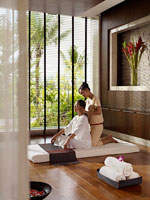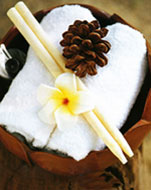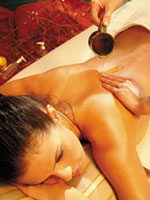THAI MASSAGE

Nuad pan boran is the name for traditional Thai Massage which dates back at
least 2,500 years. It is recognised as a practical application of the Buddhist
concept of metta, or loving kindness. Thai Massage is a known healing technique
that places emphasis on the mind and body connection and, with a skilled therapist,
it is also used as a tool in the treatment of emotional and spiritual disorders.
Thai Massage is based on the principle that invisible lines of force run through
the body. The focus is on 10 lines called “sen”. The massage
seeks to release blockages that may exist along the sen to allow the free flow
of energy throughout the body. The client is clothed and lies on a floor mattress.
The therapist applies pressure using the thumbs, fingertips, hands, feet, arms
and legs. Compression using the therapists’ body weight is also applied
to large areas of the body, such as the back and hips. Pressures combined with
manipulations stretch the spine and pull on joints to leave the body feeling
loose and relaxed, ultimately maintaining flexibility and relieving tension.
The therapist works kneeling or sitting on the floor alongside the client, working
from the feet up to the shoulders and neck, over the face and onto the scalp.
Thai Massage is a deep-massage technique that can be very relaxing. However,
it can go beyond pampering and relaxation and the more advanced practitioners
are trained to treat ailments and diseases as well.
AROMATHERAPY
Aromatherapy is not just a massage using aromatic oils, but is in fact far more
complex. A consultation by an aroma therapist is conducted prior to treatmen

t
to assess the client’s general health, diet and exercise regimes before
a personalised oil blend is created. Whilst the blend that is created can vary
from energising to relaxing, the massage technique consists mainly of long,
gentle, stroking movements to calm and soothe the nerves, focusing on lymphatic
drainage. The rate of absorption of the oil is increased during massage. Essential
oils are extracted from an array of plant sources such as petals, leaves, roots
and stalks and are composed of tiny molecules which are easily dissolved in
alcohol, emulsifiers and fats. During Aromatherapy Massage, the oils penetrate
through the skin tissue into the bloodstream. It is used in pain relief management,
treatment of emotional stress and generally helps to enhance the quality of
life.
SHIATSU
 Although its roots lie in China, Shiatsu was developed in modern-day Japan.
Also known as acupressure, the term Shiatsu translates as “finger pressure”
but similar to Thai Massage, in practice hands, knees, elbows or even feet
are used by the practitioner to apply pressure to the body. Shiatsu is based
on the principle that energy runs through the meridians which are said to
govern the internal organs and our entire metabolism. The pressure is placed
at precisely located points on the meridian lines of the body through which
energy flows – there are 14 main meridians and there are approximately
600 Shiatsu points. Applying pressure on the points has the effect of balancing
that energy to help maintain or restore the body’s natural vitality,
working on the principle that depleted energy requires toning to give relief
whereas excess energy needs sedating. In addition to localised pressure points,
Shiatsu can also involve stretching and manipulations which also require the
client’s participation in order to co-ordinate the breath with the manipulations.
Shiatsu is performed with the client dressed in loose, comfortable clothing,
on the floor on a mat or futon. Treatments can help the young or old, active
or sedentary and the method is claimed to help conditions as varied as allergies,
anxiety and depression, asthma, digestive disorders, insomnia, headache and
migraine, menstrual problems and sinusitis. Shiatsu can be used as a complete
system of health maintenance, or simply for stress reduction and relaxation.
Although its roots lie in China, Shiatsu was developed in modern-day Japan.
Also known as acupressure, the term Shiatsu translates as “finger pressure”
but similar to Thai Massage, in practice hands, knees, elbows or even feet
are used by the practitioner to apply pressure to the body. Shiatsu is based
on the principle that energy runs through the meridians which are said to
govern the internal organs and our entire metabolism. The pressure is placed
at precisely located points on the meridian lines of the body through which
energy flows – there are 14 main meridians and there are approximately
600 Shiatsu points. Applying pressure on the points has the effect of balancing
that energy to help maintain or restore the body’s natural vitality,
working on the principle that depleted energy requires toning to give relief
whereas excess energy needs sedating. In addition to localised pressure points,
Shiatsu can also involve stretching and manipulations which also require the
client’s participation in order to co-ordinate the breath with the manipulations.
Shiatsu is performed with the client dressed in loose, comfortable clothing,
on the floor on a mat or futon. Treatments can help the young or old, active
or sedentary and the method is claimed to help conditions as varied as allergies,
anxiety and depression, asthma, digestive disorders, insomnia, headache and
migraine, menstrual problems and sinusitis. Shiatsu can be used as a complete
system of health maintenance, or simply for stress reduction and relaxation.

